Margate in Maps and Pictures
compiled by Anthony Lee

|
Margate in Maps and Pictures compiled by Anthony Lee |

|
|
Margate Prints: Types of Print Click on pictures for a larger image |
CONTENTS: |
|
|
Types of Print |
|
Topographical prints showing landscapes, townscapes and major buildings were sold separately or in sets and sometimes used as plates in illustrated books. Caricature prints were also very popular with London print shops in the eighteenth and early nineteenth centuries. These topographical and caricature prints fall into three main classes, depending on whether the ink is taken from the raised surface of a printing block or plate (relief prints), from a recessed area of a plate (intaglio prints), or from specific areas of a flat plate (planographic prints). |
|
1. Relief prints – Wood engraving In a relief print the ink that forms the image is taken from the raised part of a printing block. One advantage of relief printing is that it can be combined with the printing of text in books, magazines and advertising sheets. The most common form of relief printing used a block of hard wood into which the artist cut the design across the end grain of the wood with a fine tool called a graver. The common term “wood engraving” is in fact rather confusing since wood engraving is actually a relief process. The wood often came from the box tree whose close-grained trunk grew to a diameter of about seven inches. Slices sawn across the trunk gave rectangular blocks about five inches wide. To produce a larger image the blocks were drilled through and brass bolts inserted to lock several blocks together. |
|
The section of a wood engraving of Margate shown here was taken from an article on Margate in the periodical The land we live in published by Charles Knight in 1850; it shows a clear line running down the picture on the left hand side where two separate blocks were bolted together. |
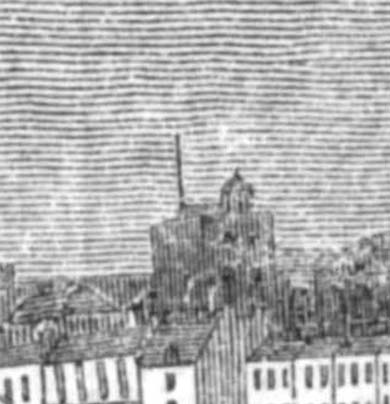
|
Wood engraving was used extensively to illustrate periodicals such as The Illustrated London News and G. W. Bonner produced many wood engravings for the Picturesque Pocket Companion to Margate, Ramsgate and Broadstairs and The Parts Adjacent published by William Kidd in London in 1831. |
|
2. Intaglio prints Intaglio prints include engravings, etchings, mezzotints, and aquatints. In all these processes the ink which produces the image is taken from the recessed area of a printing plate or block. The plate would usually be warmed, coated in ink, then wiped clean to leave the ink just in the recessed areas. Damped paper would then be placed on the plate and, in a press, the paper and plate would be squeezed together. The press, known as a rolling press, operated like a mangle, concentrating pressure on a narrow strip. The rolling press was very different from the flat press used to produce letterpress text, and so intaglio prints could not be produced at the same time as letterpress text. Intaglio printing however had the advantage that it could produce much finer detail than was possible with wood engraving. The considerable pressures used in intaglio printing often resulted in a visible plate-line outside the area of the print. |
|
2.1 Engravings Engravings were first made using a sharp tool, a burin, on soft copper plates but by the nineteenth century most engravings were on steel; the harder steel plate allowed much finer detail and made possible long print-runs. Steel line engraving was the medium for the small format engraved vignettes of Margate and other towns that became so popular from the 1840s, from London publishers such as J. Harwood, Kershaw and Son and William Frederick Rock. |
|
The example shown here is from a steel line engraving The Marine Parade and New Droit House Margate engraved by T. Garner from a drawing by G. Shepherd and published by George Virtue in 1830 in Volume 1 of W. F. Ireland’s England’s Topographer. A new and complete History of the County of Kent. |
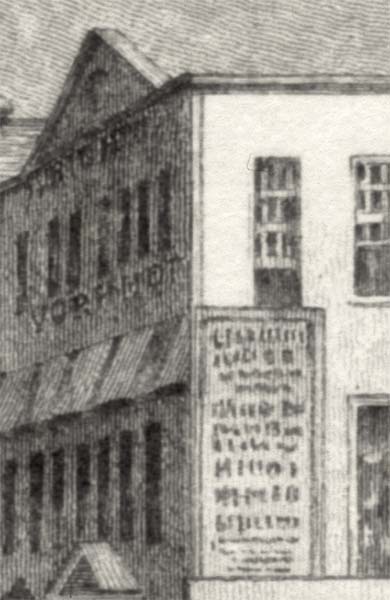
|
Stipple printing Stipple engraving was used in an attempt to reproduce tones rather than line effects. The plate was pierced with a tool containing a revolving toothed wheel, called a roulette, and with multi-pointed tools to produce a close mass of dots to imitate the effect of a light wash. Stippling was sometimes combined with line engraving but is not often found in topological prints. |
|
2.2 Mezzotints Mezzotinting is another process for producing tones, invented in the 1640s. Here the surface of the whole plate is first roughened with a rocker which throws up burrs in all directions. The burrs are then scraped down in those areas which are intended not to print black, resulting in a ‘velvety’ texture particularly suitable for reproducing oil paintings. |
|
The technique was largely used for portraits, but was used in the mezzotint of Margate Harbour produced by Thomas Lupton from a drawing made by J. M. W. Turner for the series The Harbours of England published by Smith Elder, and Co. in 1877. |
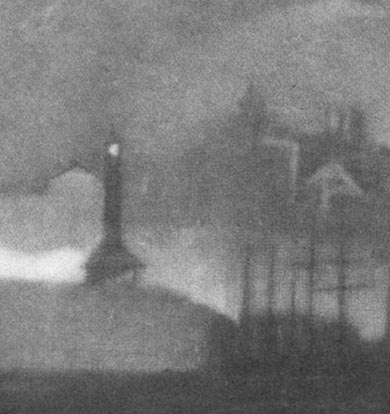
|
2.3 Etchings In the process of etching lines are incised into the plate not with a burin but by the action of acid. A metal plate is first protected by a layer of wax which is rolled or dabbed onto one surface, the face, of the plate, the back and sides being protected by varnish. The face is then smoked to blacken it, and the design of the print is drawn on the surface with a needle, breaking through the wax layer. The plate is then placed in an acid bath to etch away the metal plate where it has been exposed. A single immersion in acid gives a uniform effect but areas can then be stopped out and the plate re-immersed to give a thicker line. Etching results in a more ‘freehand’ appearance than engraving because of the lower pressures used to create the lines and because uneven biting by the acid results in a less ‘crisp’ line than engraving. |
|
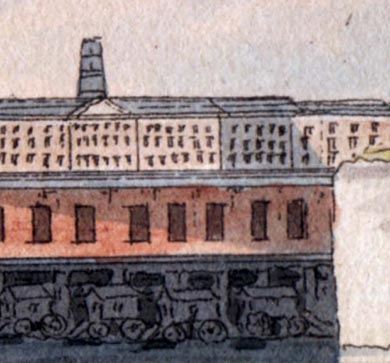
|
Shown here is a section of a hand-coloured etching of Margate Pier published in 1797. Unusually the artist, etcher and publisher was a woman, Mrs Amelia Noel (1759-1818). She was a drawing mistress who exhibited her landscape drawings between 1795 and 1804; Kent was one of her favoured locations to draw. In 1797 she published four books each containing six views of Kent, dedicated to H. R. H. Princess Charlotte, from one of which this picture is taken. |
Aquatints Aquatinting is another way of producing prints with a tone effect; the tone effect is lighter than in a mezzotint and is particularly suitable for reproducing watercolours. The process is much less laborious than the mezzotint process, producing its effects by acid treatment rather than by using a rocker. The metal plate is coated with a resin to produce a porous granular covering. In an acid bath, the acid bites around the grains to produce a fine network of lines around white dots. A graduation of tone is achieved by using an acid-resisting varnish to stop out areas which are to print lighter; lines can be added by etching. The combination of the tones and the limited line work gives aquatints their distinctive watery look. The technique was introduced into England by Paul Sandby in 1774 and was used to produce many of the early topographical prints of Margate. Aquatints were often designed to be hand coloured. By the 1830s aquatints had been largely ousted by lithography. |
|
Shown here is part of one of the first aquatints of Margate, A view of Margate with the Bathing Place, by T. Smith, published by J. Wells of Charing Cross, London in 1786. The view shows Margate harbour and the seafront of the town, with bathing machines out at sea. |

|
3. Planographic prints - lithography Lithography was invented in 1798 by Alois Senefelder and makes use of the fact that oil and water do not mix. A design is drawn in wax or some other oily substance on the polished surface of a block of limestone either using a greasy chalk pencil or by painting on greasy ink with a brush. Weak nitric acid mixed with gum Arabic is then rolled over the surface, fixing the design by filling up the pores of the stone and stopping the areas of grease from spreading. The surface is then wiped with a wet sponge so that the oily ink used for printing, applied with a roller, is only retained by the greasy areas. The stones are printed in a special press. |
|
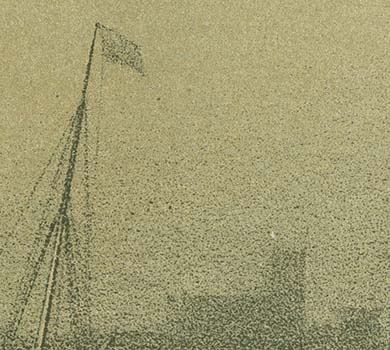
|
The detail shown here is from a coloured lithograph of The Royal Yacht off Margate. Night of March 5th 1863. Princess Alexandra became Princess of Wales in 1863 when she married Prince Edward, later to become King Edward VII. The Royal Yacht Victoria and Albert moored off Margate on the night of 5th March, causing great excitement in the town; the Alexandra Homes in Margate were named after her. |
4. Coloured Prints The first coloured prints were hand coloured aquatints and lithographs. A pioneer of early colour printing in London was Rudolph Ackermann (1764-1834) who would distribute bundles of aquatints to workers to be coloured in their own homes. The work was often done by children and sometimes whole families would be involved in the work, but the overall process was still expensive. |
|
More affordable, at eighteen pence each (equivalent to about £3 today), were small coloured lithographs produced in the 1820s by the firm of Hodgson and Co., of 16 Newgate Street, London. Under the generic title of Polygraphs, Hodgson and Co. produced coloured prints of flowers and of ‘Picturesque Views’ of towns such as Brighton, Tunbridge Wells and Margate. These were presumably coloured by hand. Shown here is one of their labels attached to a Polygraph of Brighton. |
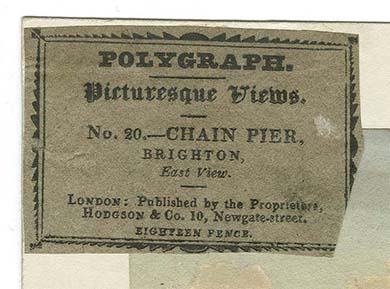
|
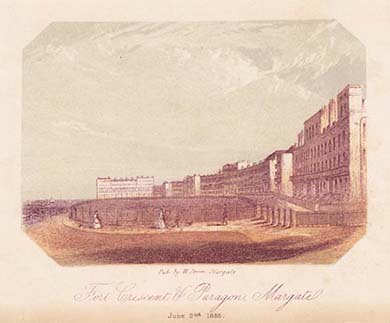
|
A book of rather poorly coloured views of Margate, ‘drawn and published’ by William Perry, Bookseller and Stationer at 4 Broad Street, Margate, was published under the title Perry’s Coloured Views in Margate. They appear to be coloured versions of a set of engravings that he had published previously. That shown here is the print of Fort Crescent and Paragon, dated June 2nd, 1855. |
Actual printing in colour was based on lithography and is known as chromolithography, a technique developed in the 1840s. Colour printing initially involved the use of many lithographic stones, one for each colour and was very expensive. Cheaper prints relied on an initial black line print with a tint or two being added using a second or third stone to make them look more colourful. |
|
A book of chemolithographs, Views of Margate and Ramsgate, was published by T. Nelson and Sons, London, at some time before the rebuilding of the Pier, containing a set of very attractive prints. That shown here is Margate Jetty from the Pier. |
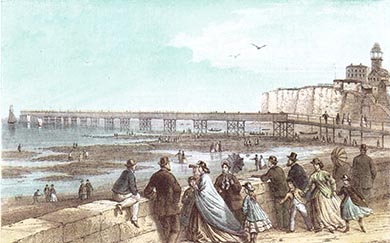
|
 |
 |
 |